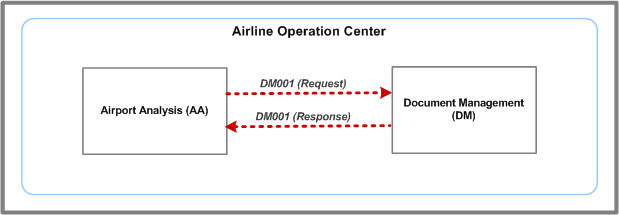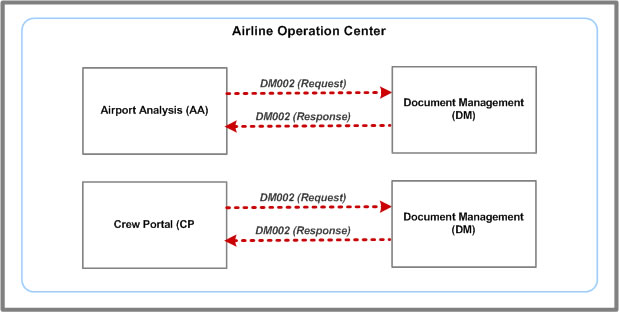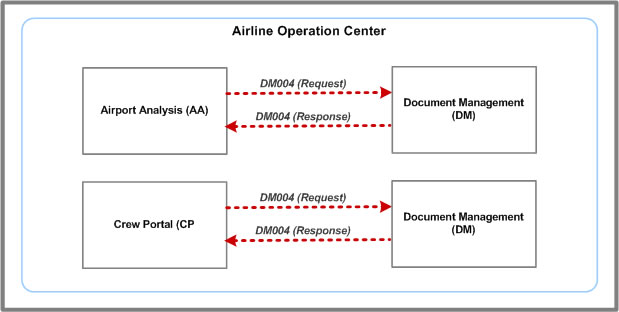
Document Management
System and Message Overviews
Document Version: 5.2
Date: March 3, 2014
Document Revision History
The following revision history table reflects all substantive changes to this document.
| Date | Description of Updates Made |
04-August-08 |
No changes since previous release. |
30-August-10 |
Updated links for new Bookshelf directory structure. |
| 23-July-13 | New XSD. |
| 3-March-14 | New XSD. |
Table Of Contents
1 Introduction
This document defines the interfaces which govern the interchange of data between a Document Management system and other systems within an Airline Operation Center (AOC). Each AOC interface is represented by a message described in an associated XSD (XML Schema Definition). The XSD defines and enforces the required, optional, and conditional data that can be included in a message.
Document Management is an AOC Integrator service used to store and retrieve documents and content utilizing an AOC document repository.
1.1 Audience
The intended audience for this document includes existing and potential Jeppesen customers, integration partners, and personnel with roles associated with application architecture, application development, system testing, implementation, and application support within Document Management.
1.2 Scope
This document discusses the Document Management messages currently supported by the Jeppesen Solution Integrator. Each message description includes the following:
- Overview for common message uses within an AOC
- Message Version Summary listing all available versions of each message
- Links to the message specifications including direct links to XSD documentation, where you can explore the XSD hierarchy and interface specifications in a navigable HTML format
- Links to the XSD source code
- Links to sample XML messages for each AOC message
Other data interfaces or formats not included in this document will be considered custom and not supported.
1.3 XML Schema/XSD
The XML schema for this ICD is published in the following file: DocumentManagement.XSD
2 Message Summary
Table 2-1 lists the messages that can be sent or handled by the application. The messages originated by this application (messages that begin with “DM”) are further discussed in Section 3 AOC Interface Messages.
Table 2-1 Message Summary
3 AOC Interface Messages
The following messages are processed by the Document Management system.
3.1 DM001 – Store Document
3.1.1 Message Overview
This message stores documents in the AOC document repository. A single DM001 message can store one or more documents associated with a single document parent node. What this means is that multiple formats of the same document can be stored using a single DM001 request message. The information for storing multiple formats of a single document is specified in the repeating group of the DM001 request message.
If a document with the same name exists, then it will not be overwritten and an error message will be returned in the DM001 response. If the specified intermediate nodes or document parent node does not exist, appropriate new nodes will be created.
Information about how the Document Management System stores documents is provided in Appendix A.
workspace: The workspace name in the NodeKeyType indicates which AOC Integrator application’s storage area will be used.
documentParentNode: The documentParentNode in the NodeKeyType identifies the root, any intermediate nodes, and the document parent node for the document being stored.
Note: Only document nodes can be children of document parent nodes.
documentContent: The content of the document is contained in the documentContent field of DocumentContentType. The vast majority of documents will be converted to base64Binary format and added to the documentContent field of DocumentContentType. Another commonly used document format is ASCII text.
name: The document name is specified in the name field of DocumentMetadataType. The document name should contain both the document file name and extension. All documents associated with the same document parent node must have a name that is unique.
type: The document type is specified in the type field of DocumentMetadataType. The document type refers to the standard MIME format of the document which includes MS Word, Adobe Acrobat pdf, ASCII text, and others. A full listing of supported MIME formats can be found at: http://www.iana.org/assignments/media-types/
documentOriginator: The author or name of the system that created the document is contained in the documentOriginator field of DocumentMetadataType.
documentAlreadyCompressed: The Document Management System will automatically compress most document files prior to storing in order to conserve space in the document repository. Some document files may already be compressed prior to their addition to a DM001 message. The documentAlreadyCompressed field of DocumentMetadataType is a means of indicating to the Document Management System if a document is already compressed or needs to be compressed by the DMS prior to storage in the document repository.
documentDate: The creation date/time of a document is contained in the documentDate field of DocumentMetadataType. This field can also be used to store the last modified date/time of the document if more appropriate. The documentDate is set by the originator of the DM001 request. The convention for the usage (i.e. creation or modification date/time) of documentDate is left to the discretion of the client software developer.
retainUntilDate: The retention date/time of a document is contained in the retainUntilDate field of DocumentMetadataType. This field is provided to enforce business rules concerning the document retention period. If used, the document cannot be modified or deleted before this date. On or after this date, the document may be either retained or deleted.
documentDescription: A text description of a document is contained in the documentDescription field of DocumentMetadataType. This field can be used to store a description of the document. This provides a means of indicating what is in the document without necessarily having to open and inspect the contents of the document.
3.1.2 Message System Flow
This message interacts with the systems as shown in Figure 1.

Figure 1. DM001 message system flow
3.1.3 Message Details
The following table provides details on the message version and includes links to the message’s technical specification.
Message Version |
DM001 vA |
Message Header Details |
msgName: DM001 |
Message Specification |
DM001 StoreDocumentRequestType |
Defined in XSD |
|
Sample Messages |
DM001vAStoreDocumentRequest.xml |
| Message Version History | No changes. |
3.2 DM002 – Retrieve Document
3.2.1 Message Overview
Retrieves documents from the document repository.
There are three options for retrieving documents from the document repository.
- Retrieve all of the documents associated with a document parent node.
To retrieve all of the documents associated with a single document parent node, specify the node’s location in the retrieveByDocumentParentNode field of the Retrieve Document Request message. - Retrieve a single specific document associated with a document parent node.
To retrieve a single document associated with a single document parent node, specify the node’s location and the document’s name in the appropriate fields of the retrieveByDocumentName of the Retrieve Document Request message. - Retrieve a single specific document by specifying its UUID.
To retrieve a single document using its UUID, specify the document’s UUID in the retrieveByUuid field of the Retrieve Document Request message.
If a request is made to retrieve a non-existent document, then an error is returned through the response message.
The response message contains a repeating group that contains the document UUID and timestamp of document repository addition along with the document content and metadata.
3.2.2 Message System Flow
This message interacts with the systems as shown in Figure 2.

Figure 2. DM002 message system flow
3.2.3 Message Details
The following table provides details on the message and includes links to the message’s technical specification.
Message Version |
DM002 vA |
Message Header Details |
msgName: DM002 |
Message Specification |
DM002 RetrieveDocumentRequestType |
Defined in XSD |
|
Sample Messages |
DM002vARetrieveDocumentRequest.xml |
| Message Version History | No changes. |
3.3 DM003 – Delete Document
3.3.1 Message Overview
This message will remove from the document repository a single specified document or all of the documents related to a single common immediate document parent node.
There are three options for deleting documents from the document repository.
- Delete all of the documents associated with a document parent node.
To delete all of the documents associated with a single document parent node, specify the node’s location in the deleteByDocumentParentNode field of the Delete Document Request message. - Delete a single specific document associated with a document parent node.
To delete a single document associated with a single document parent node, specify the node’s location and the document’s name in the appropriate fields of the deleteByDocumentName of the Delete Document Request message. - Delete a single specific document by specifying its UUID.
To delete a single document using its UUID, specify the document’s UUID in the deleteByUuid field of the Delete Document Request message.
If deletion of a non-existent document is requested, an error is returned through the response message.
If a document’s retainUntilDate has been assigned a value, then a deletion will be performed only if it does not violate the retention period rule.
If a non-document node is specified in a DM003 Delete Document request, then all of the immediate child document nodes and documents will be deleted.
To delete a single document from the document repository, specify the document’s identifier in the request message’s deleteDocument field.
Request for the deletion of a single document
- If the deletion is successful, the DM003 Delete Document Response returns “true”.
- If the deletion is unsuccessful, the DM003 Delete Document Response returns the type of error encountered and the name of the document.
Request for the deletion of a group of documents
- If the deletion is successful, the DM003 Delete Document Response returns “true”.
- If the deletion is unsuccessful, the DM003 Delete Document Response returns the type of error encountered and the names of all of the documents that had a deletion problem.
- The deletion of a group of documents results in all of the documents being deleted if no errors are encountered. In the case where an error is detected, none of the documents will be deleted. The group deletion is either completely successful or not performed at all.
If a document’s retainUntilDate has been assigned a value, then a deletion will be performed only if it does not violate the retention period rule.
If a non-document node is specified in a DM003 Delete Document request, then all of the immediate child document nodes and documents will be deleted.
The response message contains an error repeating group that contains the error codes and names of documents that could not be deleted.
3.3.2 Message System Flow
This message interacts with the systems as shown in Figure 3.

Figure 3. DM003 message system flow
3.3.3 Message Details
The following table provides details on the message and includes links to the message’s technical specification.
Message Version |
DM003 vA |
Message Header Details |
msgName: DM003 |
Message Specification |
DM003 DeleteDocumentRequestType |
Defined in XSD |
|
Sample Messages |
DM003vADeleteDocumentRequest.xml |
| Message Version History | No changes. |
3.4 DM004 – Retrieve Document Name List
3.4.1 Message Overview
This message retrieves document retrieval information based on specific query information. The purpose of this message is to support searches for information in the document repository. The message supports two query language styles – XPath and SQL which are selected in the queryStyle field of the Retrieve Document Name List request. The specific query command text is specified in the queryString field of the Retrieve Document Name List request. The DM004 response message returns directory path information to documents.
Note: Syntax checking is performed on the query string to identify harmful operations such as “delete all.” It is possible to specify an invalid format query or a destructive query such as a command to “delete all.” It is primarily the originating product’s responsibility to check for such errors prior to sending the request to the Integrator. The DMS performs this checking of the query string as a final defense against the execution of invalid or harmful query operations.
3.4.2 Message System Flow
This message interacts with the systems as shown in Figure 4.

Figure 4. DM004 message system flow
3.4.3 Message Details
Message Version |
DM004 vA |
Message Header Details |
msgName: DM004 |
Message Specification |
DM004 RetrieveDocumentNameListRequestType |
Defined in XSD |
|
Sample Messages |
DM004vARetrieveDocumentNameListSQLRequest.xml |
| Message Version History | No changes. |